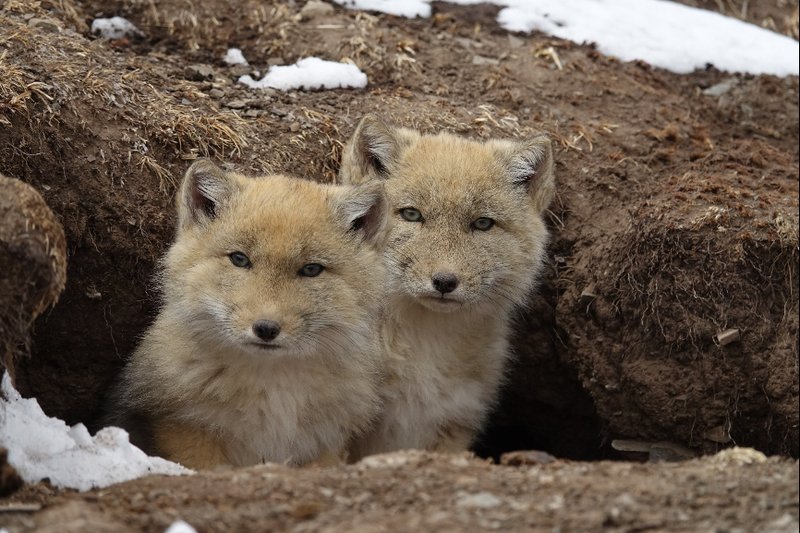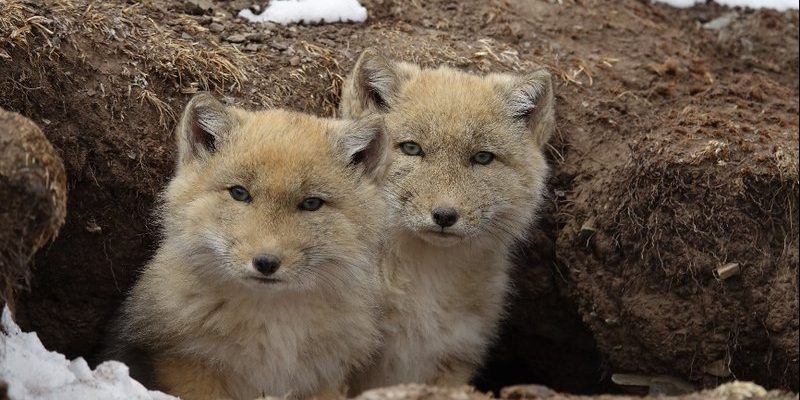
Now, imagine sipping your coffee while I share some intriguing stories about this little-known fox. From its striking appearance to its clever hunting methods, the Tibetan fox has plenty to offer. Let’s dive into some fascinating facts about this remarkable creature!
1. Unique Appearance
The Tibetan fox has a look that sets it apart from other fox species. With its short, stout body and a coat that’s often a mix of gray and reddish-brown, it blends seamlessly into its rocky environment. You might notice its pointed ears and a somewhat flat face, which gives it a distinctive look that’s almost cartoonish.
This peculiar appearance isn’t just for show. The Tibetan fox’s features help it survive in the harsh conditions of the Tibetan plateau. Its coat provides insulation against the bitter cold, while the size and shape of its ears help dissipate heat, keeping it comfortable in summer.
2. Habitat and Distribution
The Tibetan fox calls the Tibetan plateau home, a vast expanse of land that stretches across Tibet, China, and parts of India and Nepal. This area is known for its high altitude and extreme weather conditions, which can be quite challenging for most animals. But the Tibetan fox is perfectly adapted to this environment.
You’ll typically find these foxes at elevations ranging from 3,000 to 5,400 meters. They thrive in grasslands, steppe, and even near glaciers. Their choice of habitat not only provides them with food sources like small mammals and birds, but it also helps them stay hidden from larger predators.
3. Hunting Strategies
When it comes to hunting, the Tibetan fox is nothing short of a crafty predator. It primarily feeds on pikas and other small mammals. What’s fascinating is how they employ a unique hunting technique called “pouncing.” This involves stalking their prey quietly and then leaping into the air, coming down on it with precision.
This method is particularly effective in the high-altitude meadows where visibility can be limited. They also utilize their keen hearing to detect the sounds of their prey, allowing them to hunt effectively even in challenging conditions. You might say they’re like little furry ninjas of the plateau!
4. Social Structure
Unlike many other fox species that tend to be solitary, Tibetan foxes often form small family groups. This social structure helps them survive in their rugged environment. You might be wondering, how does this social behavior play into their survival?
Within these groups, they engage in cooperative hunting and can take turns caring for the young. This teamwork ensures that the entire family has a better chance of finding food and staying safe from threats. Their social bonds are strong, and you can often see them playing together or grooming one another.
5. Adaptations to Climate
The climate of the Tibetan plateau is extreme—frigid temperatures, fierce winds, and high altitudes can make survival a real challenge. Yet, Tibetan foxes have adapted beautifully. Their thick fur not only keeps them warm but also sheds water effectively during the occasional rains.
Additionally, their low metabolic rate allows them to conserve energy, which is crucial when food is scarce. They tend to be more active during the warmer parts of the day, taking advantage of the midday sun. This clever adaptation means they can thrive in an environment that would be harsh for many other animals.
6. Communication Skills
Tibetan foxes have a variety of vocalizations to communicate with one another. You might hear a mix of barks, yips, and howls, each serving a specific purpose. For example, they might yip to alert their family of danger or bark during disputes over territory.
Interestingly, they also use body language to convey messages. A fox might puff up its fur to appear larger when threatened or lower its body to show submission. This combination of vocal and non-verbal signals helps them maintain their social structure and establish dominance within their groups.
7. Reproductive Behavior
When it comes to mating, Tibetan foxes are monogamous, usually forming pairs that last for several seasons. The mating season typically occurs in late winter, and by spring, they’re ready to raise their young. The female will give birth to a litter of about 3 to 6 pups in a burrow, where they are safe from predators.
Both parents take an active role in caring for the pups, often bringing food back to the den. This nurturing behavior helps ensure the survival of the young in a demanding environment. Watching a pair of foxes work together to raise their kits is a heartwarming sight!
8. Conservation Status
Currently, the Tibetan fox is classified as Least Concern by the IUCN Red List. However, habitat loss and climate change pose threats to its population. As humans continue to develop land in the high-altitude regions of Tibet, the fox’s natural habitat is shrinking.
Conservation efforts are crucial to ensure that these fascinating creatures can thrive. Supporting organizations that work to preserve their habitats can help maintain the balance of this unique ecosystem, which is vital not only for the Tibetan fox but also for many other species that share their home.
9. Cultural Significance
In Tibetan culture, the fox often holds symbolic meaning. It’s seen as a clever creature, embodying traits of intelligence and adaptability. Folklore frequently features foxes, sometimes depicted as tricksters but also as wise beings, showcasing their dual nature.
These cultural stories highlight the fox’s importance in the region’s mythology and spirituality. They remind us of the deep connection between local wildlife and human culture, illustrating how intertwined our lives can be.
10. Future Prospects
As we look ahead, the future of the Tibetan fox hinges on the actions we take today regarding conservation and climate change. By raising awareness of their plight, we can help protect not only the Tibetan fox but also the delicate ecosystems they inhabit.
Supporting sustainable practices, protecting their environment, and respecting their habitat can make a significant difference. Honestly, it’s a small price to pay for the opportunity to continue watching these extraordinary animals thrive in their natural setting.
In conclusion, the Tibetan fox is not just another wild animal; it’s a fascinating creature with unique traits and behaviors that deserve our attention and protection. From its clever hunting techniques to its social structure, there’s a lot to appreciate about this enchanting species. So, the next time you think of foxes, remember the Tibetan fox and the remarkable adaptations that allow it to thrive in one of the most challenging environments on Earth.

